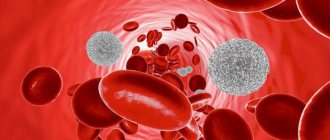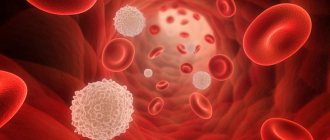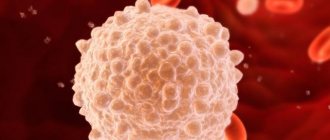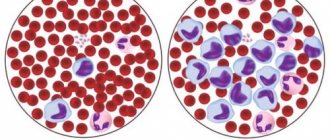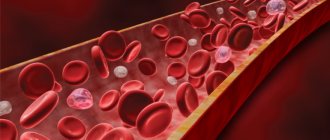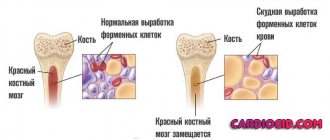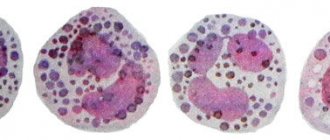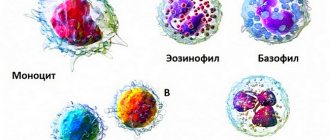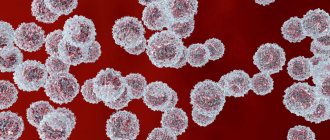White blood cells, or immune blood cells (WBCs), are an important part of our body. These elements are called immunocompetent, since they are responsible for protecting the body from external (foreign) agents.
Even in one person, the concentration of constituent elements in the blood is not the same: it can change throughout life. If the level of white blood cells decreases, leukopenia develops. This condition requires observation and careful identification of the causes. What do low white blood cells mean and what does this mean in women: let’s figure it out.
What is the danger of low white blood cell count?
A decrease in leukocytes is a laboratory sign that can go unnoticed for a long time. Minor leukopenia does not affect a person’s well-being at all, and it can only be detected after testing.
If the number of white blood cells continues to decrease and reaches a critical level (for women, the norm is 4 thousand per μl), this poses a serious threat to health . In fact, the body is deprived of natural immunity at the cellular level, which means it is unarmed against various infections.
Patients are at significantly increased risk of developing severe infections. Any such disease is dangerous for children and weakened patients due to the large number of complications that are dangerous to health and life. In addition, if you are not examined in time, you may miss cancer or AIDS.
Causes of low leukocytes
Factors influencing the decrease in the number of leukocytes, according to experts, may be different. Among them there are both physiological processes in a woman’s body and serious diseases. Let's figure out why the WBC may be lowered.
Pregnancy
Expecting a child is not only a happy time in a woman’s life, but also serious stress for the body. All systems of the body, including the immune system of the expectant mother, are rebuilt to a new “mode of operation.”
It is not surprising that the results of blood tests, even during a normal pregnancy, may differ from the generally accepted ones. Physiological leukocytosis is usually observed, in which the level of white blood cells is increased. Leukopenia is a less common phenomenon. It can be either a variant of the individual norm or indicate health problems. If blood counts remain low for a long period of time, the pregnant woman should undergo additional examination.
Lactation
Lactation is another special period in a woman’s life during which white blood cells may be slightly lower. As a rule, this condition does not require treatment and goes away on its own within a few months.
If leukopenia increases and the patient feels unwell, an urgent consultation with a doctor is necessary. Perhaps the reason for low blood cells lies in some disease.
Lack of substances
Often, a low number of leukocytes in women is caused by a lack of certain substances involved in hematopoiesis:
- vit. B1;
- vit. AT 12;
- vit. B9 (folic acid);
- Fe—iron;
- Cu - copper.
These vitamins and microelements are found in foods and are necessary for normal maturation and proliferation of WBC. Most often, their deficiency is observed during fasting, an unbalanced diet (for example, in vegetarians), as well as diseases of the stomach and intestines, in which the absorption and assimilation of food is impaired.
Drugs
Another common reason for a decrease in the level of WBC in the blood is their pathological hemolysis (destruction) while taking certain medications. Most of them are potent and are used to treat tumors, autoimmune pathologies, severe infections, epilepsy:
- cytostatics (Cyclophosphamide, Vincristine, Methocrexate);
- some antimicrobial drugs (Tetracycline, Gentamicin, Levomycetin);
- antivirals (Acyclovir);
- NSAIDs (Diclofenac, Indomethacin);
- thyreostatics (Mercazolil, Tyrosol);
- anticonvulsants (Carbamazepine).
Changes in the blood are not observed immediately after treatment, but after some time (on average 3-4 weeks).
Diseases
Sometimes a low leukocyte level is a consequence of illness. It can be:
- consequences of acute infections (condition after influenza, ARVI, chicken pox, etc.);
- chronic bacterial or viral infections of the body (tuberculosis, CMV);
- severe intoxication (meningococcemia, sepsis);
- HIV;
- acute and chronic poisoning (toxins, poisons, lead, mercury, etc.);
- primary (congenital) immunodeficiencies;
- parasitic infestations;
- autoimmune pathology (SLE, rheumatoid arthritis);
- diseases of the gastrointestinal tract (intestines, liver);
- chronic endocrine pathologies (Graves' disease, Hashimoto's thyroiditis);
- pathologies of the spleen;
- bone marrow diseases (hypoplastic/aplastic anemia);
- radiation sickness;
- oncological diseases.
Thus, in the pathogenesis of leukopenia two main processes can be distinguished:
- Impaired production of white cells due to congenital pathologies, a lack of substances involved in hematopoiesis in the body, or bone marrow damage.
- Increased destruction of immune cells due to infections.
Other factors
In addition, the cause of low WBC in the CBC in women may be regular adverse effects:
- household chemicals;
- insecticides;
- repellents;
- even hair dyes.
Reasons for the development of childhood leukopenia
An insufficient indicator of the presence of white cells, identified during the analysis, can provoke various situations. Let's consider the most typical cases.
Autoimmune diseases
Low white blood cells are caused by autoimmune diseases in children. These include specific diseases when the child’s immune system “attacks” its own healthy cells. Such pathologies are chronic; they have periods of exacerbations alternating with remissions. These are pathologies such as rheumatoid arthritis, scleroderma and systemic lupus. The exact reasons why the immune response fails to produce antibodies is not fully understood. However, such problems with the body's defense are rare and children's blood usually provides normal maintenance of immunity.
Endocrine disorders
Disturbances in the functioning of the child’s endocrine system can cause leukopenia. A drop in the number of leukocytes provokes sugar levels in diabetes and hypothyroidism. In such situations, the thyroid gland does not produce enough hormones necessary for the formation of immunity.
Medicines and toxic poisoning
Taking medications can reduce the percentage of leukocytes in a child, especially after a viral attack, when the hematopoietic system has not yet recovered. If a pediatrician prescribes them for children, it is necessary to monitor the response of the hematopoietic system by regularly taking tests. And the doctor knows how to decipher the results of such a study and take adequate measures. Leukopenia can be caused by increased doses of the following medications:
- Antispasmodics.
- Barbiturates.
- Antiparkinsonian antibiotics.
- Sulfonamide drugs.
Also, a decrease in white cells provokes toxic poisoning (intoxication). It can be identified by its characteristic features:
- weakness;
- poor appetite;
- upset stool and nausea;
- convulsions are possible.
Low level of vitamin B. Childhood vitamin deficiency often provokes a decrease in immunity, since vitamins, especially from group B, ensure normal maturation and then division of white cells. A lack of vitamins causes a change in the blood formula towards a decrease in leukocytes. It is very important for a child to get all the vitamins he needs from food. They are easier to digest with foods and are present in them, having an optimal ratio.
Congenital diseases
Kostman's disease
A reduced number of neutrophil cells is present in children suffering from Kostman's disease. The total number of all groups of leukocytes remains unchanged, since the number of other cells that perform their own tasks increases. Symptoms of the disease are noticeable through chronic infections of the mucous membranes, sinuses, and skin. The pathology is dangerous because it has an unfavorable prognosis.
Cyclic neutropenia
It is much easier to overcome a pathology such as cyclic neutropenia. The disease occurs not only in children; adults are also susceptible to it. The disease is accompanied by cycles of exacerbations and periods of satisfactory well-being. Due to the reduced content of neutrophils in the child’s blood, the immune system weakens, and the body is not able to resist intestinal and respiratory infections.
Shwachman syndrome
Hereditary pancreatic dysfunction (Shwachman syndrome) provokes the following problems:
- endocrine dysfunctions;
- In the bone marrow, the process of hematopoiesis is inhibited.
The first symptoms of pathology appear in six-month-old infants, when they begin to be transferred to artificial complementary feeding. Signs include frequent diarrhea and mental or physical retardation.
Familial neutropenia
Fewer neutrophils are detected by analysis in situations with familial neutropenia. The hereditary pathology is somewhat similar to Kostman's disease, although it has a favorable prognosis. When the disease occurs, sometimes there are no manifestations at all; a decrease in leukocytes is detected only by chance, when parents go to the clinic for other diseases, for example, in a situation with a chronic runny nose.
Other reasons
Other provocateurs of low levels of white cells include:
- Oncological processes. When cancer cells divide uncontrollably, they invade the bone marrow. Developing metastases kill tissues that produce cd3 lymphocytes.
- Infectious pathologies.
- HIV infection.
- Congenital diseases.
Decreased neutrophils
Particular attention should be paid to reducing the content of neutrophilic leukocytes. They are responsible for detecting and destroying foreign agents that enter the blood.
According to statistics, neutropenia usually develops in patients over 40 years of age. Moreover, women suffer from this disease 2-4 times more often than men.
Most often, neutrophils decrease due to severe and chronic intoxication. At the same time, less than 1500 units of white cells are found in 1 ml of blood. A critical decrease in the concentration of these blood cells is called agranulocytosis. At the same time, the patient’s body remains practically without protection, which means it is at high risk of developing complicated viral, bacterial and other forms of infections. Severe neutropenia is especially dangerous for children and pregnant women, as it can lead to death.
Dangerous complications also arise with other forms of leukopenia - accompanied by a decrease in eosinophils, monocytes and lymphocytes in the blood.
Leukocytes: their role
White blood cells are called leukocytes. Their immediate task is to provide immune protection to the body and prevent foreign agents from entering the blood. When compared with red blood cells, which are the red elements of blood, the content of leukocytes is significantly less, almost 1000 times. That is why the substance is red in color.
The blood substance contains several types of white cells that perform specific functions. Their presence in the blood varies:
- Basophils include histamine and heparin, which helps act as a catalyst for chemical processes in fat processing. Histamine stimulates phagocytosis and resists the inflammatory process. Basophils simultaneously prevent the development of blood clots.
- Lymphocytes are the most numerous representatives of leukocytes. These blood cells fight bacteria and protein antigens. Some lymphocytes synthesize immunoglobulins.
- Neutrophils are cells that perform the “suicide” function. These blood cells first engulf and then break down pathogenic cells, dying afterwards. It is the accumulation of such dead neutrophils that is the substance of pus. Functionally, neutrophils are necessary for the destruction of toxic substances, bad cholesterol and pathogenic bacteria, companions of infections. They exist in tissues even during oxygen starvation, preventing viral attacks of the infectious process. If neutrophils are low, the body resists a dangerous external viral attack.
- Eosinophils fight bacteria. They penetrate inside the infectious cell, after which it is destroyed from the inside by secreted enzymes. An accumulation of this type of white cells also occurs during an allergic reaction.
- Monocytes are classified as macrophages. These are catalysts for phagocytosis, serving to resist parasitic attacks, they block tumor tissues, and stimulate cell restoration.
Human blood contains from 4000 to 9000 μl of white cells. Their number changes all the time. Red blood cells are the most constant, so their percentage is fixed.
Normal for women
In healthy people, the level of leukocytes is in the range of 4-9 × 106/l. A low level of cells is a signal for extensive research and careful study of the altered leukocyte formula.
Table: LF norms for women
| Index | Neutrophils | Lymphocytes | Monocytes | Eosinophils | Basophils | |
| PY | SY | |||||
| Normal value, % | 1-6 | 47-72 | 19-37 | 3-11 | 0,5-5 | 0-1 |
In the study, it is necessary to pay attention not only to the concentration, but also to the ratio of groups of leukocytes. This analysis allows us to identify the “weak link” of immunity and find out the causes of leukopenia.
Types of diseases and their diagnosis
The main diseases accompanied by a low level of leukocytes are:
- hypoplasia and other hematopoietic disorders of the bone marrow;
- autoimmune pathologies;
- disorders of the gastrointestinal tract;
- infections;
- metabolic disorders;
- the action of external factors - poisoning and intoxication.
Symptoms of low white blood cell count
A slight decrease in the concentration of white blood cells has virtually no clinical manifestations. Symptoms of leukopenia become noticeable only as the underlying disease progresses.
Patients complain of:
- fever and chills;
- increased heart rate;
- inexplicable feeling of restlessness;
- headache;
- severe weakness, fatigue;
- decreased tolerance to physical activity;
- frequent ARVI;
- enlargement of the palatine tonsils;
- activation of opportunistic microflora - exacerbation of chronic infections (herpes, CMV), fungal infections of the skin and mucous membranes;
- disorders of the digestive system (abdominal pain, diarrhea);
- sometimes – enlargement of peripheral lymph nodes and spleen.
All these symptoms are a sign of intoxication of the body with foreign agents, which leukocytes must fight. The danger of the condition is that with a significant reduction in the number of WBC in the blood, generalization of the infectious process, sepsis and death can occur.
How to determine deviation
With low white blood cells, a child may experience some symptoms that should not be ignored. Laboratory research methods help confirm the assumption.
Symptoms
The syndrome in which a reduced level of leukocytes in the blood is detected is called leukopenia. The pathological process can take the following forms:
- acute (accompanied by a sharp deterioration in blood composition and severe symptoms);
- chronic (the decrease in the indicator occurs gradually, specific signs are most often absent);
- recurrent (characterized by an undulating course, in which exacerbations are replaced by temporary improvement).
In chronic leukopenia, the following symptoms are observed:
- enlarged spleen;
- change in size and pain of lymph nodes;
- lethargy, apathy, low physical activity (the child ceases to be interested in outdoor games, he begins to sleep more);
- headache;
- increase in body temperature.
The acute form of the pathology is characterized by dysfunction of the immune system caused by an infectious disease. In this case, the following symptoms occur:
- febrile syndrome (fever, chills, aches in muscles and joints);
- headache;
- nose and gum bleeding;
- increased heart rate;
- weight loss
- change in voice timbre.
If leukocytes are low as a result of the administration of chemotherapy drugs, hemorrhagic complications (subcutaneous hemorrhages, bleeding) and febrile syndrome develop. The skin turns pale, the child begins to get tired quickly.
Analyzes
To detect leukopenia in children, detailed blood tests are performed, which involve counting each type of blood cell included in the leukocyte formula. If the leukocyte count is below normal, additional diagnostic procedures are prescribed:
- biochemical blood test (helps identify disturbances in the functioning of internal organs);
- immunogram (implies a study of the functions of the immune system);
- enzyme-linked immunosorbent test (aimed at detecting antibodies to pathogens of viral infections).
Important information: What are leukocytes and how many should be in the blood (the norm for a healthy person)
Treatment of leukopenia – restoration of leukocyte levels
Treatment of patients with a low concentration of WBC in the blood can only be prescribed by a doctor, taking into account the results of the examination, the main cause of the pathology, age and other individual characteristics. In some cases, it is enough for the patient to adjust his diet by adding foods rich in B vitamins and beneficial minerals. In others, serious and long-term therapy will be required.
General recommendations for all patients with leukopenia (and therefore reduced immunity) include the following:
- If possible, avoid crowded spaces with a lot of people (shopping centers, public transport). If necessary, wear a medical mask.
- Do not contact people who have visible signs of acute respiratory viral infection.
- Carefully process (clean from dirt, wash in running water) raw vegetables and fruits before consumption.
- It is good to boil/fry meat, eggs or fish.
- Drink only boiled water and milk.
- Eat healthy. Make sure that the diet is as varied as possible, rich in vitamins, micro- and macroelements.
- As recommended by your doctor, take a course of multivitamins.
- Seek medical help promptly if acute infections develop or worsen chronic infections.
Medication
It is known that leukopenia is associated with absolute or relative deficiency of WBC. The longer this process continues, the more dangerous its consequences can be. Therefore, if necessary, medication treatment should be started as early as possible.
The patient is prescribed drugs aimed at stimulating hemo- and leukopoiesis. This:
- means for stimulating cellular metabolism - Leukogen, Methyluracil, Pentoxyl;
- medications for the repetition of colony-stimulating factors - Lenograstim, Sagramostim, Filgrastim.
The use of such drugs can be supplemented with the prescription of dietary supplements, natural adaptogens and immunostimulants.

